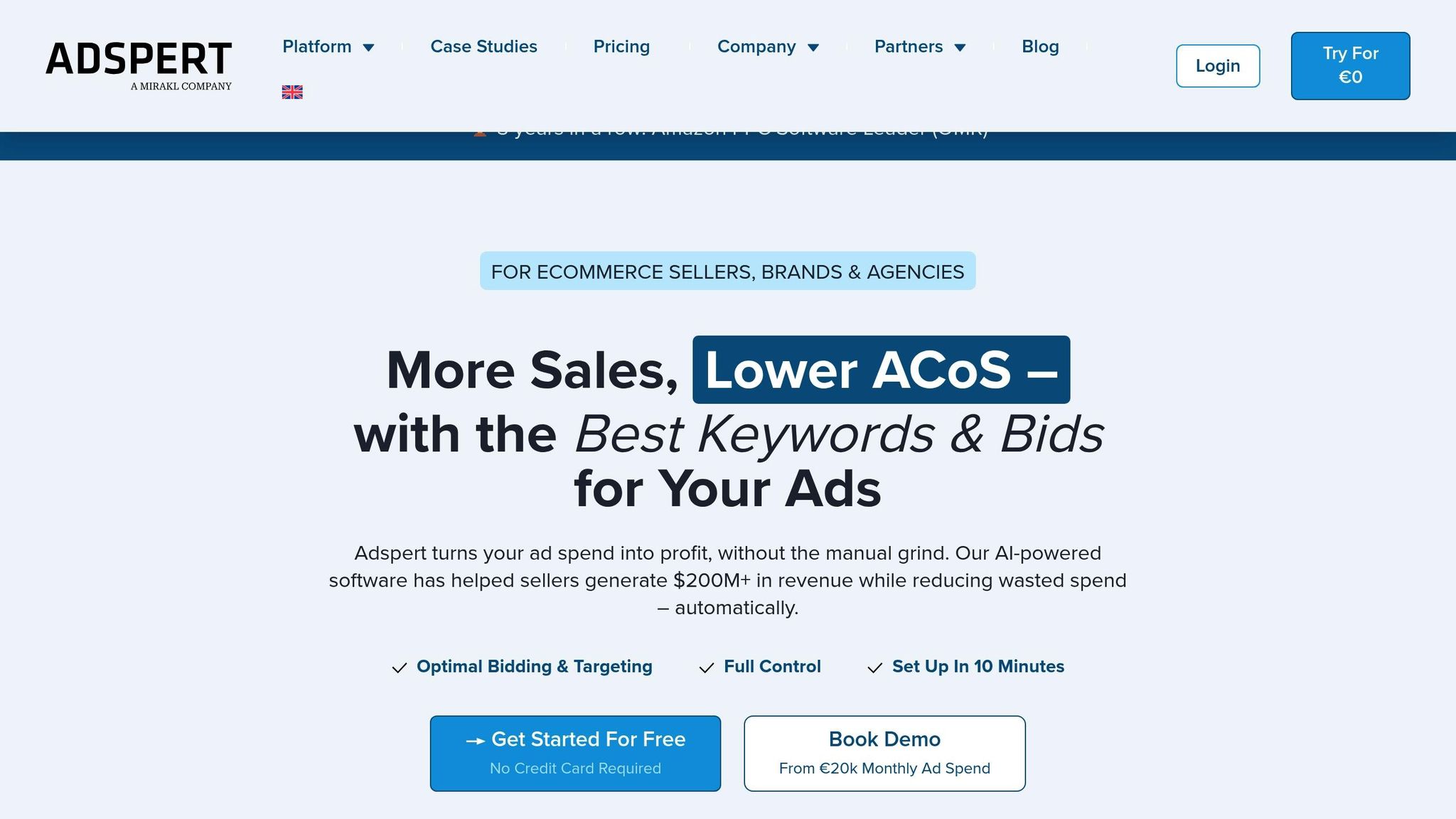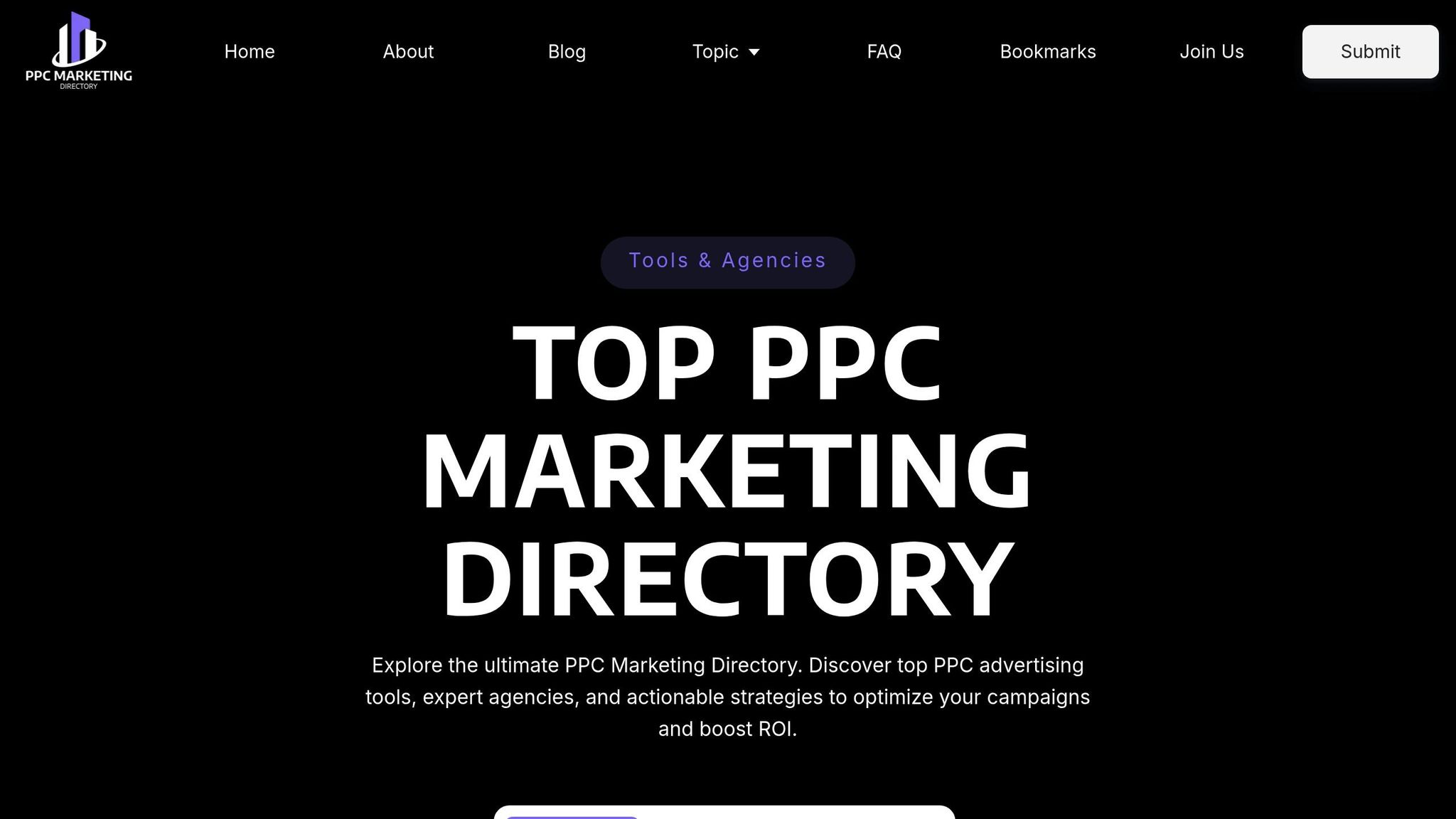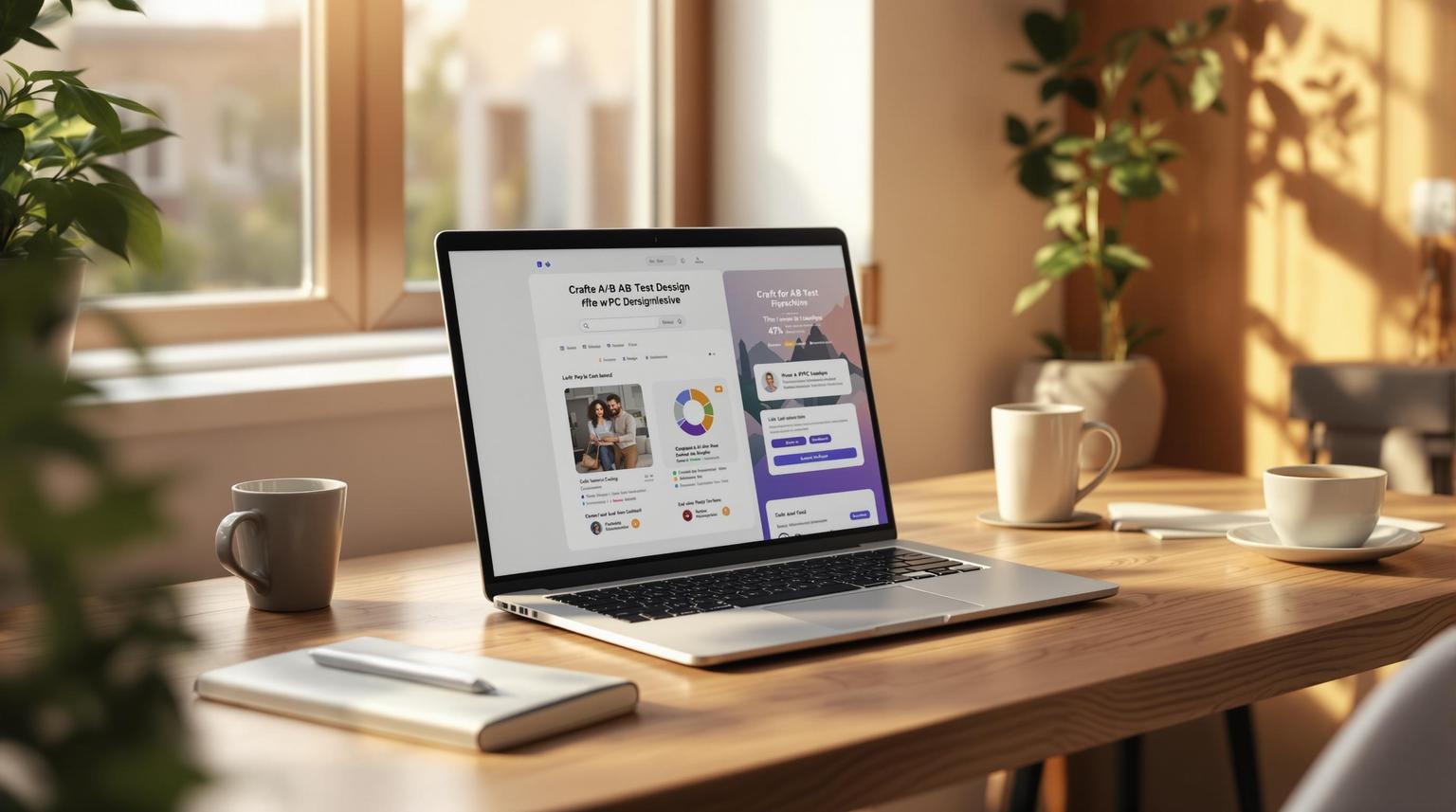Inefficient PPC bid management wastes budgets and misses opportunities. Here's how feature engineering combined with machine learning transformed campaigns:
- 55% revenue growth on average.
- 27% lower Cost per Click (CPC).
- 18% higher Click-Through Rate (CTR).
- 28% better Return on Ad Spend (ROAS).
This approach used time-based patterns, external data (e.g., market trends, weather), and automated bid adjustments. The result? Reduced costs, improved conversions, and over 40 hours saved monthly. By integrating advanced algorithms and real-time data, campaigns became more precise and efficient.
For businesses, leveraging tools like the Top PPC Marketing Directory can simplify implementation and drive similar results.
PPC AI: How Adspert’s Algorithm Nails Bid Optimization

Feature Engineering Process
Time-based features play a crucial role in identifying seasonality, trends, and temporal patterns, which help fine-tune bid adjustments as market dynamics shift. Here's a closer look at how these features are developed.
Time-Based Feature Creation
To uncover meaningful insights, rolling averages across various time intervals are calculated. This approach smooths out short-term fluctuations and highlights broader trends. Additionally, features that track changes based on the time of day and the day of the week are included. These metrics provide a clear picture of recurring user behaviors, enabling more precise and responsive bid adjustments.
Machine Learning Bid Adjustment Implementation
Using time-based analysis, a machine learning system was developed to optimize bid adjustments across campaigns. This system was designed to handle a high volume of decisions with precision and adapt quickly to changing market conditions. The groundwork laid here supports a closer look at the model's structure and operational workflow.
Model Architecture and Workflow
The system relied on an ensemble of algorithms, leveraging time-based features and historical data to optimize bidding strategies. By combining methods that analyzed past trends with those capturing more complex, non-linear campaign behaviors, the system offered a balanced approach. Rolling averages and time-based metrics played a key role in identifying patterns.
The workflow operated on frequent refresh cycles, ensuring performance data stayed current. When predictions were highly confident, bid adjustments were applied automatically. In cases where confidence was lower, the system flagged recommendations for manual review by campaign managers.
This machine learning layer was seamlessly incorporated into the existing real-time bidding framework. It made percentage-based bid adjustments while maintaining the campaign's overall structure, ensuring smooth integration without disrupting existing strategies.
Automation and Scale
To manage large-scale campaigns efficiently, the system utilized a dynamic automation framework. This framework adjusted computational resources based on campaign activity, ensuring optimal performance during high-demand periods and cost efficiency during quieter times. Custom APIs facilitated secure, real-time data exchange between the machine learning system and PPC platforms, enabling timely adjustments.
During peak activity, the system allocated additional processing power to maintain accuracy and speed. Meanwhile, a comprehensive dashboard provided campaign managers with detailed insights, including performance metrics, confidence scores, and adjustment histories. This interface allowed for fine-tuned control, letting managers set custom thresholds for automation or temporarily pause machine learning adjustments for specific campaigns or ad groups.
With built-in safety features like volatility detection, the system maintained stability even during market fluctuations. By integrating seamlessly with real-time bidding, it ensured that machine learning insights translated into actionable improvements for campaign performance.
sbb-itb-89b8f36
Results and Performance Analysis
The refined bid adjustment algorithms, combined with feature engineering, have driven impressive results across multiple performance metrics. These implementations have not only boosted efficiency but also significantly reduced costs, with some companies reporting performance gains as high as 100%.
Performance Improvements
The data highlights the clear benefits of feature engineering in bid optimization. Companies have seen measurable improvements across key metrics, as shown in the table below:
| Metric | Before Implementation | After Implementation | Improvement |
|---|---|---|---|
| Revenue Increase | Baseline | +55% average | 55% boost |
| Cost per Click (CPC) | Standard rates | Reduced rates | 27% reduction |
| Click-Through Rate (CTR) | Baseline performance | Enhanced performance | 18% lift |
| Conversion Rate (CR) | Standard conversion | Optimized conversion | 9% lift |
| Return on Ad Spend (ROAS) | Manual optimization | AI-powered optimization | 28% improvement |
For example, Viant Technology introduced its AI Bid Optimizer in 2025, achieving performance improvements of up to 100% and reducing costs by 24% to 40% compared to traditional manual bidding systems. Similarly, Coty, a global beauty brand, enhanced its ROAS from Amazon ads by 28% and increased its digital purchase view rate by 48% through the integration of bid modifier APIs.
The operational advantages were equally noteworthy. Companies reported efficiency gains of 100%, saving over 40 hours of manual work each month thanks to automated bid optimization management. Additionally, predictive modeling accuracy improved by 10% with a model capable of analyzing 30 million data points. AI-powered systems also proved to be 14 times faster at adjusting bids compared to human efforts. These results provide a strong foundation for best practice recommendations.
Key Learnings and Best Practices
Several key insights have emerged from these advancements, offering valuable guidance for future bid optimization efforts. For instance, SplitMetrics' AI ROAS Bid Optimization enabled Aveola to scale user acquisition, reducing cost per install (CPI) and increasing app installs within just three weeks. Improved audience segmentation contributed to an 18% lift in CTR and a 9% increase in CR. Additionally, one implementation achieved a 45% reduction in operational costs by automating the model maintenance cycle.
United Tech also benefited from SplitMetrics' AI Bid Optimization in 2025, improving advertising effectiveness by optimizing keyword bids. This allowed teams to shift their focus toward more strategic initiatives, further enhancing productivity. These examples underscore the transformative potential of AI-driven bid optimization systems.
Integration with Top PPC Marketing Directory

After diving into the role of feature engineering and machine learning in bid optimization, it’s clear that external tools now play a critical role in scaling these advancements. The Top PPC Marketing Directory simplifies this process by connecting businesses with specialized bid management solutions, making it easier to implement complex data processing and algorithm-driven strategies.
To develop AI-powered bid optimization, access to the right tools and expert agencies is essential. This platform excels at cutting down the time and effort spent researching multiple vendors by offering an organized approach to vendor selection. Marketing teams can quickly identify tools that enable machine learning integration, automated bid adjustments, and real-time performance tracking. With this streamlined process, the directory provides a solid foundation for exploring specific campaign optimization resources.
PPC Campaign Optimization Resources
The Top PPC Marketing Directory is packed with tools that directly enhance bid optimization. Its categories for campaign and bid management offer solutions capable of processing large datasets, while its performance tracking tools provide the analytics needed to measure revenue growth and cost savings.
For organizations working on similar projects, the directory highlights essential resources like A/B testing tools and programmatic advertising solutions. These tools are crucial for validating how well features perform and for automating bid adjustments at scale. Beyond bid management, the directory also includes resources for landing page and ad copy optimization, both of which help improve traffic quality and boost conversion rates. Together, these tools create a comprehensive approach to improving campaign performance and return on ad spend.
For businesses looking to save time and streamline operations through automation, the directory’s retargeting and remarketing tools add another layer of optimization. These tools work seamlessly with advanced bid management systems, allowing marketing teams to build robust technology stacks that deliver both immediate results and long-term growth potential. The platform’s ability to compare solutions side-by-side ensures that teams can find the right combination of tools to meet their specific needs.
Additionally, the directory’s focus on connecting users with expert agencies is a game-changer for companies lacking in-house expertise in machine learning or feature engineering. These partnerships help bridge the gap between ambitious optimization goals and practical implementation, ensuring that advanced algorithms and data processing can be effectively applied across various industries and business models.
Conclusion
This case study highlights how feature engineering can elevate bid optimization from a process bogged down by manual adjustments to one driven by data and automation. By addressing the shortcomings of traditional bid management and incorporating machine learning algorithms, it becomes clear how carefully chosen features can significantly enhance campaign performance.
Our approach placed a strong emphasis on selecting the right features - such as time-based, historical, and contextual data - and combining them with real-time automation. This strategy not only improved cost efficiency and boosted conversion rates but also minimized the need for manual intervention, ensuring precise and consistent bid adjustments.
The results speak for themselves. Performance analysis revealed substantial improvements across key metrics, including reduced cost-per-acquisition and noticeable revenue growth. These outcomes underscore the importance of refining models continuously and maintaining a robust data infrastructure to support complex algorithmic solutions.
Additionally, the Top PPC Marketing Directory offers businesses the tools they need to implement advanced optimization strategies. By connecting teams to specialized bid management tools, machine learning platforms, and expert agencies, the directory simplifies the process of finding the right resources. This eliminates the time-consuming research phase, enabling companies to build the tech stack necessary for effective feature engineering.
To achieve meaningful optimization, organizations need to pair advanced algorithms with the right tools and expertise. This combination of technical know-how and specialized resources fuels measurable growth and provides a competitive edge in PPC campaigns.
FAQs
How does feature engineering help improve metrics like CPC and CTR in bid optimization?
Feature engineering plays a key role in boosting performance metrics like cost-per-click (CPC) and click-through rate (CTR). It does this by transforming raw data into meaningful insights. By designing features that reflect patterns in historical performance - such as shifts in CTR, CPC trends, ad placement data, and user behavior - algorithms can make sharper predictions and smarter bidding choices.
For instance, these features might reveal which keywords or audience groups are more likely to drive higher engagement or lower costs. With this information, bid adjustment algorithms can allocate budgets more efficiently, leading to improved CTRs and lower CPCs. The result? Better campaign outcomes and a stronger return on investment (ROI).
What challenges might businesses face when using machine learning for automated bid adjustments in PPC campaigns?
Businesses that use machine learning to automate bid adjustments in PPC campaigns might face a few obstacles along the way. A big challenge is the loss of control over bidding and targeting decisions. Sometimes, these automated systems may not align perfectly with a company’s specific goals or branding needs. Another issue is that machine learning thrives on large amounts of high-quality data, which smaller businesses might struggle to provide.
There are other challenges too. High upfront costs can make these systems a tough investment, especially for smaller operations. Integrating them into existing workflows isn't always smooth, and they require constant monitoring and fine-tuning to keep up with shifts in competition or market trends. On top of that, some businesses hesitate to adopt such tools due to concerns about data privacy or a general resistance to embracing new technologies.
That said, with thoughtful planning and consistent oversight, machine learning can be a game-changer, helping businesses refine their bidding strategies and improve campaign results.
How can businesses use the Top PPC Marketing Directory to improve bid optimization and boost campaign performance?
Businesses looking to enhance their pay-per-click (PPC) campaigns can turn to the Top PPC Marketing Directory. This resource connects companies with highly-rated PPC tools, expert agencies, and services that excel in bid optimization and campaign management. It’s a one-stop hub for discovering tools that streamline bidding, fine-tune targeting, and apply data-driven strategies tailored to specific goals.
By offering a centralized platform, the directory makes it easier for businesses to compare options and choose solutions that fit their needs. The result? Smarter bid adjustments, stronger ROI, and overall improvements in campaign performance.


